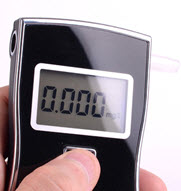Debunking Some Common Breathalyzer Myths

“If you’ve been drinkin’ then suck on Lincoln.” Many New Yorkers have heard breathalyzer myths like this one. There is usually at least some truth in myths like this one. But as Alexander Pope once wrote, “A little knowledge is a dangerous thing.”
DUI cases have some facts as well as some myths. The fact is that the state has a small army of lawyers and investigators. These individuals care little about “justice” and instead only want to get convictions. Many defendants need an attorney to try to level this playing field if indeed you did not drink and drive. While I personally do not defend these cases, those of us who love forensic work, keep up with the real scientific developments, and also the fables about what is going around with people trying to beat a test.
Penny Suck
Breathalyzers convert certain breath particles to electrical impulses and thus measure breath alcohol content. Copper disrupts this process. But there are two problems with this theory.
First, pennies only contain trace amounts of copper. They are mostly made of zinc and other cheap metals. Second, Breathalyzers measure alcohol in the lungs as opposed to alcohol in the mouth. A person would have to suck on a lot of copper to affect the results. I am not sure how many pennies that entails, but it is probably many more than the mouth can comfortably hold.
Beer Chug
Nevertheless, mouth alcohol does affect the test results. That’s the basis of the alcohol-chugging defense. Sudden, rapid consumption artificially inflates Breathalyzer results. Prosecutors are sometimes hard-pressed to establish the defendant’s BAC level while driving as opposed to the BAC level after testing.
In 2012, a Florida man caused a fatal accident while intoxicated. While the police were not looking, he left the crash scene, went to a Circle-K, and drank a beer. He later pleaded guilty, so no one is sure if the defense would have worked.
But most likely, a jury would have found the man guilty anyway. Prosecutors can call expert witnesses who can estimate the defendant’s driving BAC based on the test BAC. Furthermore, brazen behavior like this usually does not go over well with New York jurors or any jurors for that matter. Yet it does bring up a point, in a more serious criminal case involving whether a named defendant was drunk at the time of a felony, for instance (not a driving case which has an non-rebuttable presumption in many states ), there needs to be two tests at a reasonable interval to see whether the BAC is rising to properly interpret results especially those taken with blood rather than a breath test, and make a retrograde determination at the time of the crime.
Exercise and Hyperventilation
A frequently-cited study concluded that rapid breathing and vigorous exercise decreased BAC readings by about 10 percent. It stands to reason that rapidly deflating the lungs would achieve that result. Unfortunately, there is more to the story.
The effect is very short-lived. So, the officer must allow you to do pushups right before you test. That’s not very likely. Hyperventilating before leaving the bar probably would not work either. Such activity leaves a person short of breath and prone to making driving mistakes.
Coffee and Breath Mints
Substances like these have nothing to do with the test itself. But caffeine makes drivers feel more alert, and breath mints mask the odor of alcohol. So, officers may have less evidence for reasonable suspicion. Without such evidence, they cannot legally proceed to the next phase of the arrest, which usually involves the field sobriety tests.
But this evidentiary standard is very low. An officer only needs an evidenced-based hunch. And, the caffeine/gum method does nothing about bloodshot eyes, slow reaction times, or slurred speech. Furthermore, it is game over if the defendant admits to even having one drink.
Upshot: Don’t drink and drive!
